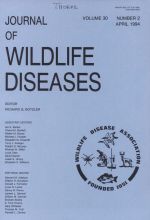Silastic implants containing levonorgestrel (LNG) were evaluated as a contraceptive in captive white-tailed deer (Odocoileus virginianus). Six adult females and six female fawns received either six or nine implants in autumn. Each implant contained 36 mg of LNG. Blood was analyzed by radioimmunoassay to determine LNG release profile for 5 mo post-implantation. Serum LNG concentrations rose significantly (P = 0.0005) 3 days post-implantation, leveled off after 7 days, and did not change (P = 0.5913) during the remaining 5 mo. Mean (±SE) LNG concentrations for all months were higher (P = 0.0377) in adult and fawn females implanted with nine versus six rods (138.1 ± 14.4 versus 56.7 ± 12.3 pg/ml, respectively). Serum LNG levels did not differ between adults and fawns. Five of the six implanted adult females had normal estrous cyclicity; three of these five adult females became pregnant in the first year. Four implanted females (two yearlings and two adults) were monitored during a second year, and housed with a fertile buck; three of them became pregnant. We do not recommend the use of LNG in deer.
How to translate text using browser tools
1 April 1994
LEVONORGESTREL IMPLANTS AS A CONTRACEPTIVE IN CAPTIVE WHITE-TAILED DEER
Lisa M. White,
Robert J. Warren,
Richard A. Fayrer-Hosken

Journal of Wildlife Diseases
Vol. 30 • No. 2
April 1994
Vol. 30 • No. 2
April 1994
contraception
fertility control
levonorgestrel
Odocoileus virginianus
white-tailed deer




